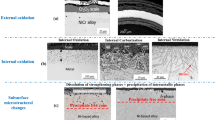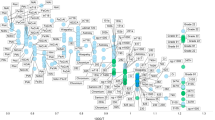Abstract
An approach is suggested for describing the rate of degradation of alloys subjected to the combined effects of high-temperature oxidation and erosion. The basis for this approach is essentially empirical, and is drawn from observations of the kinetics and scale morphologies of alloys in laboratory tests. The two major assumptions used are that the alloy surface is always covered by an oxide layer, and that only oxide (not alloy substrate) is removed by the erosion process. The mode of erosion is not explicitly defined. The rate of erosion, that is, the amount of oxide lost in a given erosion event, is taken to be proportional to the thickness of the oxide layer. The relationships developed have been found capable of accurately describing the shapes of oxidationerosion kinetic curves, and the predicted thickness of the steady-state oxide layers remaining on the alloys agreed reasonably with experimental observations.
Similar content being viewed by others
References
I. G. Wright, V. Nagarajan, and R. B. Herchenroeder, inProc. of TMS-AIME Symp. on Corrosion-Erosion Behavior of Materials, K. Natesan, ed. (AIME, 1978), pp. 268–312.
I. G. Wright, V. Nagarajan, and W. E. Merz, Paper No. 3, NACE Corrosion/81 (1981).
V. Nagarajan, I. G. Wright, and W. E. Merz, Paper No. 5, NACE Corrosion/81 (1981).
I. G. Wright and V. Nagarajan, inProc. of the U.K. Corrosion 1984 Conf. (Institution of Corrosion Science and Technology, Birmingham, U.K., 1984), pp. 55–62.
I. G. Wright, V. Nagarajan, and J. Stringer,Oxid. Met. 25, 175 (1986).
S. Majumdar, K. Natesan, and A. Sarajedini, ANL/FE-81-1, DE88 009363 (Argonne National Lab., Argonne, Illinois, December 1987).
B. T. Ellison and C. J. Wen, inTutorial Lectures in Electrochemical Engineering and Technology, R. Alkire and T. Beck, eds. (AIChE Symp. Series, No. 204, Vol. 77, 1981), p. 161.
C. W. Price, UCRL-53468 (Lawrence Livermore National Lab., Livermore, California, November 1983).
N. Birks and F. S. Pettit, ARO 17421. 1-MS (University of Pittsburgh, April 1984).
C. T. Kang, F. S. Pettit, and N. Birks,Metall. Trans. 18A, 1785 (1987).
J. Stringer, Corrosion/86, Paper No. 90 (1986).
H. Abd-El-Kader and S. M. El-Raghy,Corrosion Sci. 26, 647 (1986).
W. Wei and D. Deffenbaugh, DOE/MC/22077-2022, DE86 001081 (Southwest Research Institute, San Antonio, Texas, February 1986).
V. Nagarajan, I. G. Wright, and A. J. Markworth (Final Report on EPRI Research Project 979-8, November, 1983).
Author information
Authors and Affiliations
Rights and permissions
About this article
Cite this article
Markworth, A.J., Nagarajan, V. & Wright, I.G. An approach to modeling simultaneous high-temperature oxidation and erosion. Oxid Met 35, 89–106 (1991). https://doi.org/10.1007/BF00666502
Received:
Revised:
Issue Date:
DOI: https://doi.org/10.1007/BF00666502




